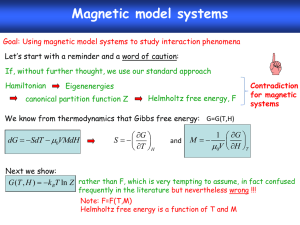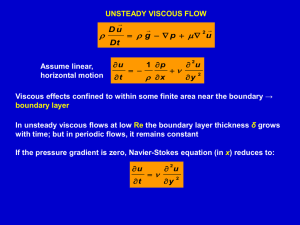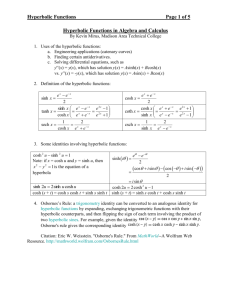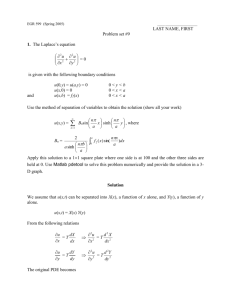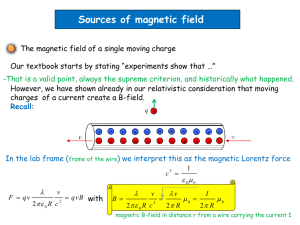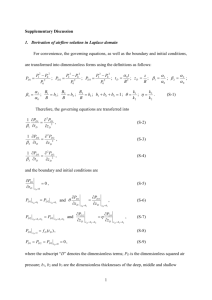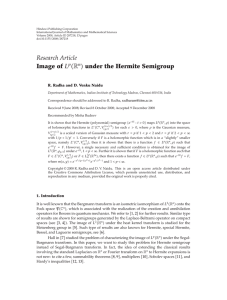Random Motion on Simple Graphs
advertisement
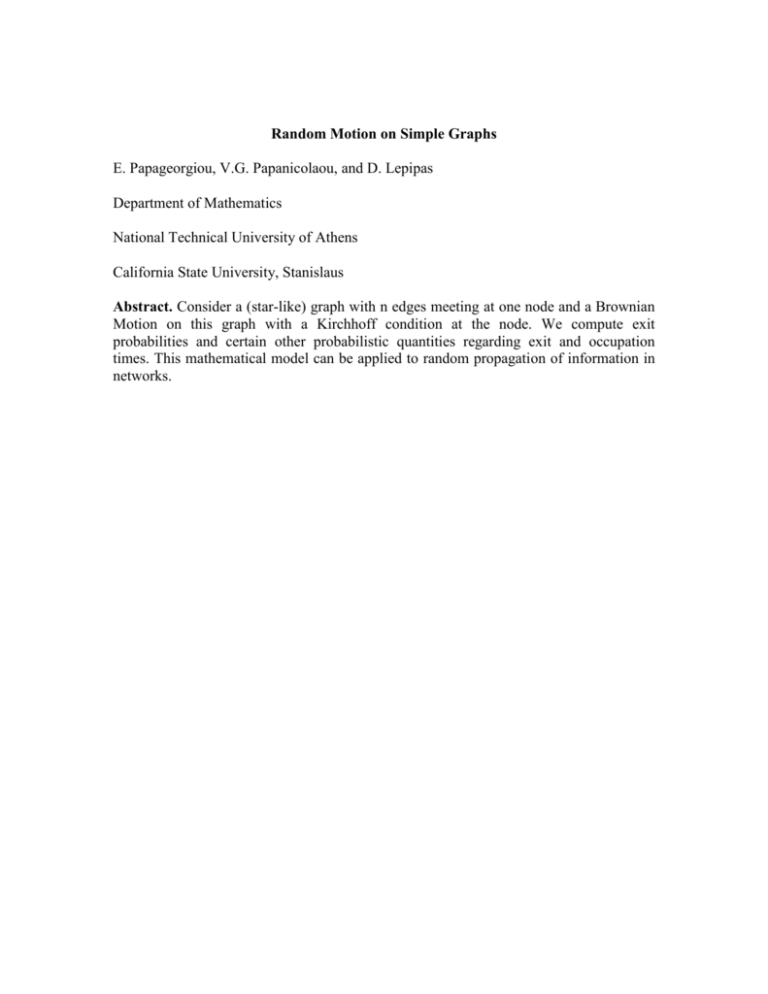
Random Motion on Simple Graphs
E. Papageorgiou, V.G. Papanicolaou, and D. Lepipas
Department of Mathematics
National Technical University of Athens
California State University, Stanislaus
Abstract. Consider a (star-like) graph with n edges meeting at one node and a Brownian
Motion on this graph with a Kirchhoff condition at the node. We compute exit
probabilities and certain other probabilistic quantities regarding exit and occupation
times. This mathematical model can be applied to random propagation of information in
networks.
1 Introduction
Let S be the set consisting of n semiaxes S1 ,..., Sn , n 2 , with a common origin 0 and
X t the Brownian motion process on S , namely the diffusion process on S whose
infinitesimal generator L is
1
Lu u ''
(1)
2
where
u (u1,..., un ) ,
together with the continuity conditions
u1 (0) ... un (0) (2)
and the so-called ‘Kirchhoff condition’
u1' (0) ... un' (0) 0 (3)
It is well-known that L defines a (unique) self-adjoint operator on the space
n
L2 ( S ) L2 (S j )
j 1
n
L (0, )
j 1
2
The process X t does a standard Brownian motion on each of the semiaxes and, when it
1
hits 0 , it continues its motion on the j -th semiaxis, 1 j n with probability
(see,
n
e.g., [3]). For notational clarity it is helpful to use the coordinate x j , 0 x j , for the
semiaxis S j , 1 j n . Notice that, if u (u1,..., un ) is a function on S then its j -th
component, u j , is a function on S j , hence u j u j ( x j ) .
In this article we study certain issues regarding exit (or hitting) times and occupational
times of X t . Our results extend certain classsical results for the standard Brownian
motion on
(e.g. the continuous gambler’s ruin problem—see, e.g., [1]) which actually
corresponds to the case n 2 ( x1 x , x2 x where x 0 ). Possible applications may
include random flow of information in simple networks.
2 Exit Times and Exit Probabilities (Explicit Calculations)
On each semiaxis S j , 1 j n , consider the point b j 0 . These points define the
(bounded) subset of S
Sb
n
j 1
{x j : 0 x j b j }
(thus S b consists of n line segments of lengths b1 ,..., bn , with a common initial point,
namely 0 ). We assume that X 0 S b and we denote by T the exit time of S b , i.e. the
smallest time such that X t b j , for some j 1,..., n .We also introduce the events
B j { X T b j } (4)
If X 0 x j , we denote the associated probability measure by P
xj
and the expectation by
E . Let us now consider the following boundary value problem for u (u1 ,..., un )
1 ''
u j u j 0 , j 1,..., n (5)
2
where is a complex parameter and u (2),(3) namely
u1 (0) ... un (0) , (6)
xj
u1' (0) ... un' (0) 0 , (7)
together with the boundary conditions
u1 (b1 ) 1 (8)
and
u j (b j ) 0 , j 1 (9)
The solution u of the above problem has the Feynman-Kac representation (see, e.g., [2]
or [4])
x
u j ( x j ) u j ( x j ; ) E j [e T 1B1 ] (10)
as long as
Re{} 1
where 1 is the smallest eigenvalue of L acting on S b with Dirichlet (i.e. 0 ) boundary
conditions at x j b j , j 1,..., n . In particular (10) is valid for all 0 . It is
straightforward to check that 1 is the smallest positive zero of
F ( ) cot( 2 b1 ) ... cot( 2 bn ) .
Set bM max{b1,..., bn } . Since F (0 ) and F (( 2 / 2bM2 ) ) , it follows that
0 1
2
2bM2
Let us calculate the solution u of the problem (5)–(9). First assume 0 . To satisfy (5),
(8), and (9) we must take
u1 ( x1 ) A1 sinh[ 2 ( x1 b1 )] cosh[ 2 ( x1 b1 )] (11)
and
u j ( x j ) Aj sinh[ 2 ( x j b j )] , 2 j n (12)
To determine the constants A1 ,..., An we have to use (6) and (7). From (6) we get
A1 sinh( 2 b1 ) cosh( 2 b1 ) A2 sinh( 2 b2 ) ... An sinh( 2 bn ) ,
hence
Aj
A1 sinh( 2 b1 ) cosh( 2 b1 )
, 2 j n (13)
sinh( 2 b j )
By (7) we have
A1 cosh( 2 b1 ) sinh( 2 b1 ) A2 cosh( 2 b2 ) ... An cosh( 2 bn ) 0 . (14)
Using (13) in (14) yields
A1 cosh( 2 b1 ) A1 sinh( 2 b1 ) coth( 2 b2 ) ... A1 sinh( 2 b1 ) coth( 2 bn )
sinh( 2 b1 ) cosh( 2 b1 ) coth( 2 b2 ) ... cosh( 2 b1 ) coth( 2 bn )
or
A1 sinh( 2 b1 )[coth( 2 b1 ) coth( 2 b2 ) ... coth( 2 bn )]
sinh( 2 b1 )[1 coth( 2 b1 ) coth( 2 b2 ) ... coth( 2 b1 ) coth( 2 bn )]
Therefore
n
A1
1 coth( 2 b1 ) coth( 2 bk )
k 2
n
coth(
k 1
(15)
2 bk )
and hence (13) becomes
Aj
1
sinh( 2 b j )sinh( 2 b1 )k 1 coth( 2 bk )
n
, (16)
for 2 j n .
Let us also analyze the somehow exceptional case 0 . In this case the equation (5)
becomes
u ''j 0 , j 1,..., n ,
and the boundary conditions are again (6), (7), (8), and (9). By formula (10) we can see
immediately that the solution u has the probabilistic interpretation
x
x
x
u j ( x j ) u j ( x j ;0) E j [1B1 ] P j [ B1 ] P j [{ X T b1}] (18)
To satisfy (17), (8), and (9) we must take
u1 ( x1 ) A1 ( x1 b1 ) 1 ,
and
u j ( x j ) Aj ( x j b j ) , 2 j n .
To determine the constants A1 ,..., An we have to use (6) and (7). From (6) we get
Ab
1 1 1 A2b2 ... Anbn ,
hence
Ab 1
, 2 j n . (19)
Aj 1 1
bj
On the other hand, from (7) we get
A1 A2 ... An 0 . (20)
Using (19) in (20) yields
Ab
Ab
1
1
A1 1 1 ... 1 1 ...
b2
bn
b2
bn
or
1 1
1
1
1
A1b1 ( ... ) ... .
b1 b2
bn
b2
bn
Therefore
A
b
n
k 2
n
1
1
(1/ bk )
(21)
(1/ bk )
k 1
and hence (19) becomes
Aj
1
b j b1 k 1 (1/ bk )
n
, (22)
For 2 j n .
We summarize the above results in the following theorem:
Theorem 1. For 0 (or more generally for 0 , Re{} 1 , where 1 is the
smallest eigenvalue of L acting on S b with Dirichlet boundary conditions at x j b j ,
j 1,..., n ) we have
E xi [e T 1B j ]
1
sinh( 2 bi )sinh( 2 b j )k 1 coth( 2 bk )
n
sinh[ 2 (bi xi )] ,
if i j . Also
E j [e T 1B j ] sinh[ 2 (b j x j )]
x
[
1
sinh( 2 b j ) k 1 coth( 2 bk )
n
cosh( 2 b j )]
sinh[ 2 (b j x j )]
sinh( 2 b j )
If 0 , the above formulas become
E xi [1B j ] P xi [ B j ] P xi [{ X T b j }]
1
b j k 1 (1/ bk )
n
(1
xi
),
bi
if i j . Finally
E j [1B j ] P j [ B j ] P j [{ X T b j }]
x
x
x
xj
bj
1
b j k 1 (1/ bk )
n
(1
Remark. If we set xi 0 (or x j 0 ) in the above formulas, we obtain
E 0 [e 1B j ]
In particular ( 0 )
1
sinh( 2 b j ) k 1 coth( 2 bk )
n
E 0 [1B j ] P0 [ B j ] P0 [{ X T b j }]
. (23)
1
b j k 1 (1/ bk )
n
(24)
xi
).
bi
